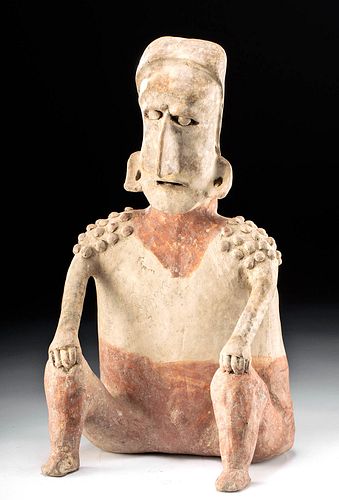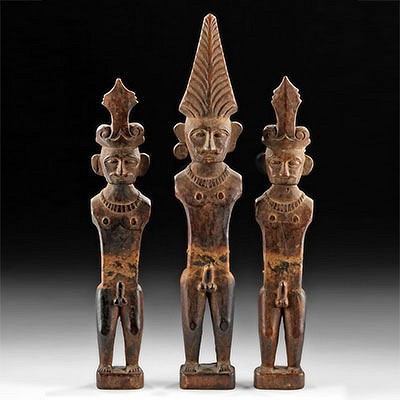Jalisco Ameca Grey Pottery Seated Elder Male
Lot 134c
About Seller
Artemis Fine Arts
686 S Taylor Ave, Ste 106
Louisville, CO 80027
United States
Selling antiquities, ancient and ethnographic art online since 1993, Artemis Gallery specializes in Classical Antiquities (Egyptian, Greek, Roman, Near Eastern), Asian, Pre-Columbian, African / Tribal / Oceanographic art. Our extensive inventory includes pottery, stone, metal, wood, glass and textil...Read more
Estimate:
$1,100 - $1,600
Absentee vs Live bid
Two ways to bid:
- Leave a max absentee bid and the platform will bid on your behalf up to your maximum bid during the live auction.
- Bid live during the auction and your bids will be submitted real-time to the auctioneer.
Bid Increments
| Price | Bid Increment |
|---|---|
| $0 | $25 |
| $300 | $50 |
| $1,000 | $100 |
| $2,000 | $250 |
| $5,000 | $500 |
| $10,000 | $1,000 |
| $20,000 | $2,500 |
| $50,000 | $5,000 |
| $100,000 | $10,000 |
| $200,000 | $20,000 |
About Auction
By Artemis Fine Arts
Jun 25, 2020
Set Reminder
2020-06-25 10:00:00
2020-06-25 10:00:00
America/New_York
Bidsquare
Bidsquare : CLEARANCE - Ancient, Pre-Columbian, Ethno Art
https://www.bidsquare.com/auctions/artemis-gallery/clearance---ancient-pre-columbian-ethno-art-5264
Featuring discounted pricing on antiquities from Egypt, Greece, Italy, and the Near East...plus Viking, Asian, Pre-Columbian, Tribal, Russian Icons, Spanish Colonial, Fine Art, more! Starting prices have been reduced up to 65% from original auction prices - perfect for dealers and collectors. Artemis Fine Arts info@artemisfinearts.com
Featuring discounted pricing on antiquities from Egypt, Greece, Italy, and the Near East...plus Viking, Asian, Pre-Columbian, Tribal, Russian Icons, Spanish Colonial, Fine Art, more! Starting prices have been reduced up to 65% from original auction prices - perfect for dealers and collectors. Artemis Fine Arts info@artemisfinearts.com
- Lot Description
**Originally Listed At $600**
Pre-Columbian, West Mexico, Jalisco, Ameca Grey type, Protoclassic Period, ca. 100 BCE to 250 CE. A hollow-built pottery elder male figure seated upon a broad base with bent legs balancing his poised demeanor. The nude man has a petite phallus between his red-slipped legs, holds slender arms and closed hands atop his knees, and fifty-five applied nodules on his shoulders that scholars posit are 'ritual scarification pellets.' His elongated head bears sunken cheek bones and recessed eye sockets indicative of advanced age, a prominent aquiline nose, and a thin mouth between tall, pierced ears, all beneath a smooth brow and a simple cap. Size: 8.75" W x 16.375" H (22.2 cm x 41.6 cm)
West Mexican shaft tomb figures like this example derive their names from the central architectural feature that we know of from this culture. Jalisco, located on Mexico's southwestern coast, was part of the shaft tomb culture during this time, along with neighbors in nearby Colima and Nayarit. These people would build generally rectangular vertical or near-vertical shafts down from the ground level - usually about 3 to 20 meters deep - through tepetate, the volcanic tuff that makes up the geology of the region, to narrow horizontal tunnels that led to one or more vaulted or rounded burial chambers.
Exhibited in the University of St. Thomas Art Gallery.
Provenance: ex-private collection of the late Father Bader, University of St. Thomas, Houston, Texas, USA, acquired prior to 2000
All items legal to buy/sell under U.S. Statute covering cultural patrimony Code 2600, CHAPTER 14, and are guaranteed to be as described or your money back.
A Certificate of Authenticity will accompany all winning bids.
We ship worldwide and handle all shipping in-house for your convenience.
#154377Professionally repaired from multiple pieces, with restoration to left foot, and resurfacing with overpainting along new material and break lines. Losses to small areas of feet and one shoulder pellet as shown. Abrasions and nicks to limbs, body, and head, with fading to original pigment, and light encrustations. Nice earthen deposits and root marks as well as great remains of original pigment throughout.Condition
- Shipping Info
-
All shipping is handled in-house for your convenience. Your invoice from Artemis Gallery will include shipping calculation instructions. If in doubt, please inquire BEFORE bidding for estimated shipping costs for individual items.
-
- Buyer's Premium



 EUR
EUR CAD
CAD AUD
AUD GBP
GBP MXN
MXN HKD
HKD CNY
CNY MYR
MYR SEK
SEK SGD
SGD CHF
CHF THB
THB















